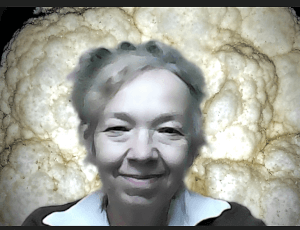Each of us is a multiplicity -a unity that is multiple in itself- bacteria, fungi, archaea, human. We have rhizomic (in the philosophical meaning) relationships with our cutaneous microbiome (micro-organisms that live on and in our skin) that involve creative, adaptive, symbiotic or parasitic entangled evolution. Our microbiome evolved with us for thousands of years, or more precisely, as said, involves because involution, to use Deleuze and Guattari terminology, is creative, not procreative.
We also have a strong emotional relation of love/hate to our microbiome. It heals our wounds, protects us against skin diseases. It is deeply rooted under our epiderma, where direct interconnections and exchanges with our blood are done, unseen, intimate. But we hate it, because it shows what we want to hide, our smell, our animality. Can’t we see our microorganisms as lovers that wrap us with their protective bodies, with whom we are deeply interconnected? We are, in a way, partners in a queer, biophilic relation, biophilia being “an erotic-ethical affiliation between human and nonhuman life in experimental symbioses whose ecological benefits are sensed and desired, if not fully recognizable.” (Dianne Chisholm, Biophilia, Creative Involution and the Ecological Future of Queer Desire). And it is what would make our relationship with our microbiome queer, not in reference to a sexual minority but to an interspecific complex coupling.
During this artist talk, I will present some scientific data on the cutaneous human microbiome, its diversity, origin, showing how microbiome acts in wounds recovery, protection against diseases, etc. Specific to each of us, our microbiome takes part of our identity in different ways. Being the result of an (unconscious) mutual choice, linked to the chemical compounds present on/in our skin and to our immune system responses, our cutaneous microbiome blurs the border between human and non-human organisms. Some recent researches in immunology unveil complex, paradoxical relationships, incompatible with some conventional -and anthropocentric- concepts of immunology, blurring our specific identity.
Which concealed secrets could our microbiomes reveal about us? I have grown on pieces of special fabric tens of microbiomes from people living in different countries and different climates. Looking at those colorful patchworks, we could establish groups, make links, trying to see social identity in a different way.
As said, the microorganisms that compose our microbiome react to protect us, that means they can perceive us, they are sentient. Most scientific studies neglect this aspect. We will speak about rhizome concept, interconnectivity, sentience and what we could learn about us looking at humans from outside our anthropocentrical vision. This concept is in opposition to the arborescent one, hierarchic, where human is the paramount being, and microbiome -as well as other living beings- is perceived at best as an assistant, and at worst as an enemy.
Maybe could emerge another view of our human condition as spongy creatures floating in an ocean of micro-organisms where there is no dominant, no Creation’s king.
Back






